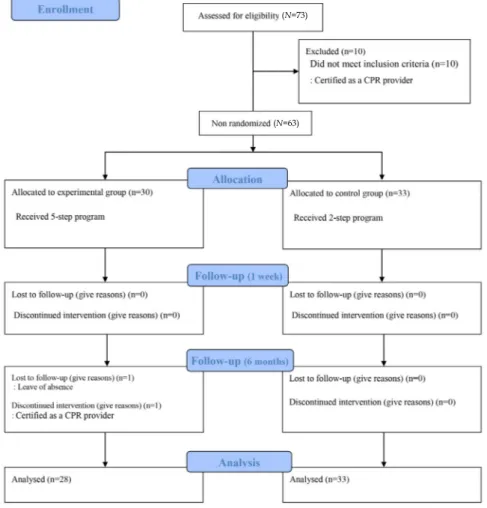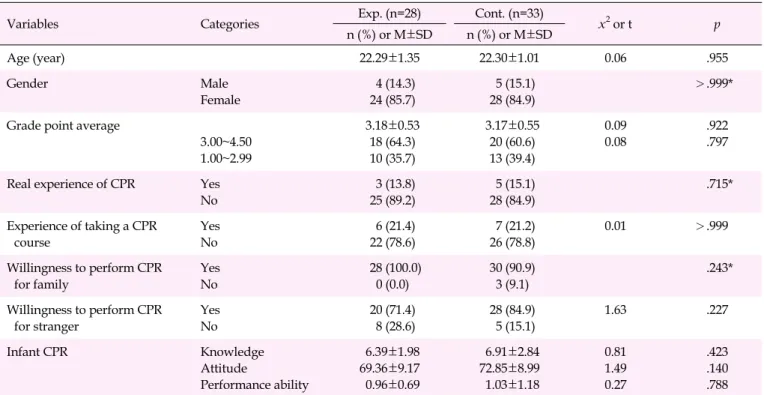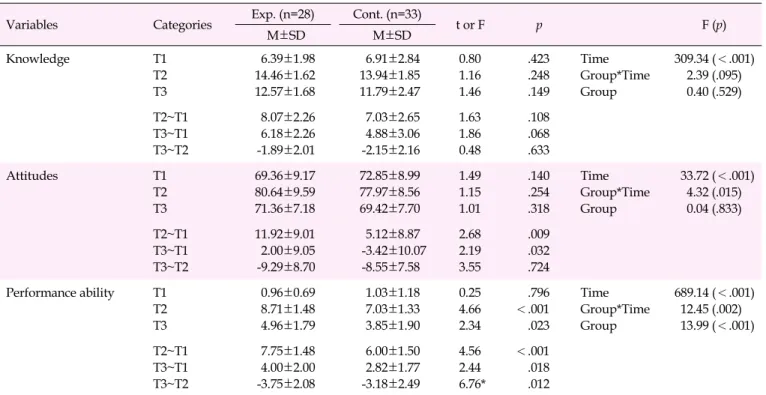https://doi.org/10.4094/chnr.2019.25.1.17 CHNR
The Effects of the 5-step Method for Infant Cardiopulmonary Resuscitation Training on Nursing Students' Knowledge, Attitude, and Performance Ability
Jin Young Kim
1, Hye Young Ahn
21
Assistant Professor, Department of Nursing, Seoyeong University, Gwangju;
2Professor, College of Nursing, Eulji University, Daejeon, Korea
Purpose: The purpose of this study was to examine the effects of an infant cardiopulmonary resuscitation (CPR) training program that applied the 5-step method on the knowledge, attitudes, and performance ability of nursing students in terms of enhancement and sustainability. Methods: Sixty-one nursing students (28 in the experimental group and 33 in the control group) from D city participated in this study. Data were collected from April 25 to December 15, 2016. The experimental group and control group received infant CPR education using the 5-step method and the traditional method, respectively. The outcome variables were measured 3 times (pretest and posttest at 1 week and 6 months after training) Results: There were significant differences in attitude (t=2.68, p=.009) and performance ability (t=4.56, p<.001) between the groups at 1 week after training, as well as in sustained performance ability at 6 months after training (F=6.76, p=.012). Conclusion: The 5-step method of infant CPR training was effective for improving performance ability in a sustained manner and promoting a positive attitude. Therefore, it is recommended that nursing students, as infant CPR novices, receive training using this effective method.
Key words: Cardiopulmonary resuscitation; Infant; Education
INTRODUCTION 1. Need for Study
According to the Korean nationwide out-of-hospital car- diac arrest (OHCA) registry (2006-2007), infants show a sig- nificantly higher incidence of cardiac arrest than children and adolescents, but have the lowest rate of being discharged alive [1]. Although infants experience a lower incidence of cardiac arrest than adults, cardiac arrest in infants is an important is- sue that cannot be ignored. Although preventing cardiac ar- rest is important, it is also crucial for the first responder to give infant cardiopulmonary resuscitation (infant CPR), with the aim of increasing the survival rate and preventing neuro- logical sequelae. What the medical staff is able to do in an emergency setting can be divided into 2 categories: identify- ing the patient's problems and solving those problems. The former involves clinical reasoning, while the latter requires performing skills to solve the problems. In particular, since there are limited chances to receive training for infant CPR, ef- fective educational strategies are needed to optimize learning outcomes [2]. In addition, since infant CPR is characterized by a greater loss of performance ability than knowledge with time [3], infant CPR education should focus on improving and Corresponding author Hye Young Ahn
https://orcid.org/0000-0002-5353-671X College of Nursing, Eulji University,
771-77, Gyeryong-ro, Joong-gu, Daejeon 34824, Korea TEL +82-42-259-1715 FAX +82-42-259-1709 E-MAIL ahanaya@eulji.ac.kr
*This article was adapted from a dissertation by Jin Young Kim in partial fulfillment of the requirements for the doctoral degree at Eulji University.
Received Aug 28, 2018 Revised Oct 3, 2018 Accepted Oct 30, 2018
This is an Open Access article distributed under the terms of the Creative Commons Attribution Non- Commercial License (http://creativecommons.org/licenses/by-nc/4.0/) which permits unrestricted non- commercial use, distribution, and reproduction in any medium, provided the original work is properly cited.
maintaining performance ability. Professional institutions, in- cluding the American Heart Association (AHA), have recom- mended 'watching and repeating' a video as an essential method [4]. This method can be applied easily, and conveys knowledge of CPR, causes positive changes in attitude, and improves performance ability; however, it has limitations re- lated to sustainability [5]. Additional methods include the im- mediate remediation method [6,7] and a video self-instruction program [8] for infant and child CPR. However, the effects of training differ depending on the subject and the educational method, and it is necessary to apply various educational methods for nursing students to determine which is most suitable.
Infants have different anatomical structures from those of adults, such as the airway, and experience different causes of cardiac arrest, which often involve respiratory failure that re- duces the oxygen content in the blood even before the onset of arrest. For these reasons, it is impossible to apply adult CPR techniques to infants who are experiencing cardiac arrest. To perform infant CPR correctly, specific education is therefore necessary.
As CPR has become more important from a societal per- spective since the late 2010s, nursing schools have designated CPR as a regular subject, making it a part of emergency nurs- ing [9]. However, their training primarily focuses on adult CPR, to the point of almost excluding infant CPR [10]. In addi- tion, universities have different educational infrastructures and experience some level of randomness in the administra- tion of educational programs [10]. It is therefore necessary to develop a program that can improve and sustain performance ability, which is the most important learning goal, on the basis of improved knowledge of infant CPR and positive attitudes, taking the educational environment of nursing students into account.
Skills education is a psychomotor domain in pedagogy [11], for which the learning process was categorized into 5 steps by George and Doto [12]. In the first step of the 5-step method (overview), the educator motivates the learner to learn by pre- senting him/her with concepts and goals of the skills. In the second step (silent demonstration), the learner observes the full course of the skilled educator's demonstration. In the third step (demonstration with comment), the educator dem- onstrates the skill with comments for each step. During this process, the educator and the learner interact with each other through feedback. In the fourth step (verbalization), learners practice explaining the skill verbally. Through this step, learn- ers acquire further knowledge and improve their under- standing and memory [13]. In the fifth step (practice), learners practice the skill under the educator's direction, and any er- rors are corrected immediately to prevent the consolidation of
incorrectly learned skills [14]. The 5-step method clearly pres- ents the role of the educator, with explicit instructions at every stage in order to improve the educational environment. The 5-step method is composed of a detailed learning process that is facilitated by the role of the educator [12]. According to a previous study [15], the most important factor for enhancing the effectiveness of skill education is individual feedback and practice under supervision of the educator. Therefore, the 5- step method is suitable to apply for infant CPR education among nursing students.
A literature review regarding the 5-step method found that it had the positive effects of improving performance ability and reducing the time needed to learn skills when it was ap- plied to skill education for dental care students [16]. Teaching materials for peritoneal dialysis patients and their caregivers have been developed on the basis of the 5-step method and are expected to make peritoneal dialysis safer and more efficient for the patients when a nurse, who is the educator, uses these materials 3 [1]. Manual defibrillation training for medical stu- dents also involved the 5-step method, which resulted in learners being more satisfied with the educator's feedback and verbalization [17].
Since nursing students may gain experience responding to cases of infant cardiac arrest during their clinical practice, un- like general college students, it is possible for their knowledge and performance ability of infant CPR to be positively af- fected by receiving general knowledge related to infants and infant CPR training during their undergraduate studies.
Moreover, CPR performance ability is positively correlated with knowledge and attitudes [18]. On this basis, the present study aimed to apply the 5-step method developed by George and Doto [12] to infant CPR education for nursing students and to measure its educational effects and sustainability, with knowledge, attitudes, and performance ability as variables.
2. Objectives
This study aimed to analyze the effects of an infant CPR training program that applied the 5-step method on nursing students' knowledge, attitudes, and performance ability, and to assess the sustainability of those effects.
3. Hypotheses
The experimental group receiving infant CPR training with the 5-step method would show higher scores for knowledge, attitudes, and performance ability than the control group at 1 week after the training program.
The experimental group receiving infant CPR training
with the 5-step method would maintain higher scores for
CPR=Cardiopulmonary resuscitation.
Figure 1. Process flow diagram.
knowledge, attitudes, and performance ability than the control group at 6 months after the training program, in- dicating the sustainability (the variation between 1 week and 6 months after the training program) of its effects.
METHODS 1. Study Design
This was a quasi-experimental study using a non-equiv- alent control group non-synchronized design to analyze the effects of an infant CPR training program applying the 5-step method for nursing students.
2. Subjects
The proximate population of this study comprised juniors who were taking a lecture on pediatric nursing education at a university in D City, understood the purpose of this study, consented to participate, and had no CPR license. To mini-
mize the diffusion effect, taking the participants' learning schedule into account, the first and second groups engaging in clinical practice for pediatric nursing in the former part of the course formed the control group and the third and fourth groups engaging in clinical practice in the latter part of the course formed the experimental group. The G*Power Analysis 3.1 program [19] was used to estimate the sample size, and re- peated-measures analysis of variance (ANOVA) (measuring 3 times repetitively) found a total minimum number of 46 per- sons, with an effect size of .40 [20], a significance level (⍺) of .05, and testability (1- β ) of .90. Taking a dropout rate of 10% in- to account, the required sample size was estimated to be a to- tal of 52, and this sample size was exceeded, with 30 partic- ipants in the experimental group and 33 in the control group.
Two participants dropped out of the experimental group (1 for a personal reason [temporary absence from college] and 1 because of CPR license acquisition), yielding a total of 61 par- ticipants (28 in the experimental group and 33 in the control group) (Figure 1).
(N=73)
(N=63)




